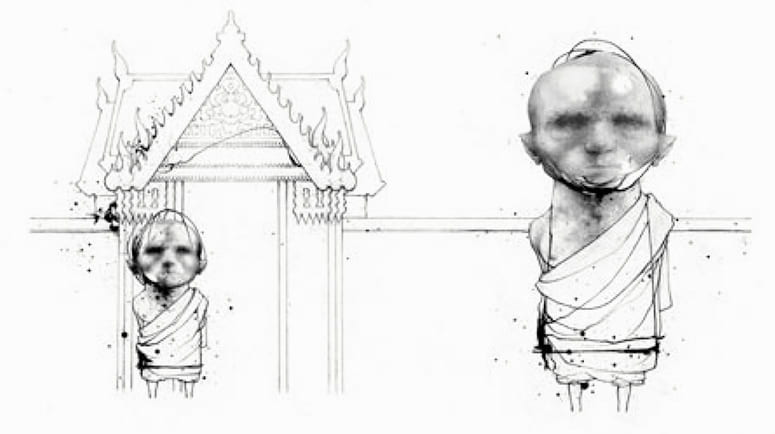Dialogue
From Thai Monks, a Rapid Response
By Blaine Johnson
Natural disasters are a rare occurrence in Thailand. Apart from the occasional flood, the last notable natural disaster was a terrible windstorm that ravaged Bangkok nearly 45 years ago. So you can imagine how unprepared the Thai people were for the tsunami that leveled the Andaman Coast late last year. There was, of course, no warning of the impending destruction. There were no alarms, no alerts, no sirens. For many of the thousands of victims, there was not even a name for what happened.
For better or worse, the Thai government had no preparation or practice in managing a disaster on the scale of the tsunami. Consequently, many of the people I spoke with felt that the government’s reponse to the tsunami would be, at best, clumsy. It seemed to most observers that the devastation was too widespread, and that resources were too scarce and too scattered. But over the next few days, the Thai people proved their spiritedness in responding to such an unprecedented tragedy. Not only was the response immediate and strong, it also gained momentum with every passing day.

Illustration by Andrew Zbihlyj
Perhaps most important to the success of the relief effort was the consistent support provided by Buddhist monks. In temples located in the tsunami-affected areas, they organized almost instinctively. From the first few moments after the wave hit, barefoot monks opened wide the doors of their temples to wounded victims, orphans, and refugees. Within the space of a few hours, these monks managed to convert temple lecture halls into functional medical wards, and were the first to tend to many of the victims. Without bandages and gauze available, some monks dressed the wounds of the injured with portions of their saffron robes.
With time, military officials, public health experts, and relief workers arrived at the temples with equipment and medical staff. With the further assistance of the monks, the temples became the backbone of the relief effort, and the focus of almost all activity related to disaster response. As a service to those who donated their time and energy to the cause, the monks provided free shelter, food, and telephone services to hundreds of volunteers.
Over the next few days, many more wounded were brought to the temples for treatment. Monks worked alongside doctors to provide medical assistance to the injured. At the same time the bodies of the deceased were brought to the temple for storage and identification. Monks assisted volunteers and doctors in handling and dis-posing of thousands of corpses.
For many monks, years of mental training on the transitory nature of life prepared them to carry out the uninviting task of handling decomposed corpses. One monk that I spoke with credited his years of meditation on the impermanence of the body as being one of the most effective preparations for the realities he faced during the tsunami relief effort.
The relevance of the Buddhist temple and the Buddhist monks was not lost on those who participated in the relief effort. One military official said that without the temples there would have been utter chaos in the first days after the disaster. The work of the monks was crucial to the entire process. Even now, almost two months after the disaster, as crisis management shifts to long-term rehabilitation, the monks are still hard at work.
One of the main tasks at hand is to comfort the thousands of people who have been affected by the tsunami disaster. With over 5,000 people confirmed dead and over 3,000 still missing, it has been an overwhelming task to provide counseling to those survivors who have suffered loss. Recognizing the shortage of spiritual counselors, one Thai NGO has raised funds to send groups of monks from across the country to provide counseling services to those now living in refugee camps. Monks trained in universities as psychologists are now going door-to-door in many seaside villages, offering free counseling to victims.
In fact, the response of Buddhist monks to the tsunami tragedy has renewed many Buddhists’ faith in the importance of the sangha (monk community) as the center of Thai community. In both Thailand and Sri Lanka, the success of Buddhist involvement in the tsunami relief effort has led to a surge in interest among Buddhists to engage their faith in relief and development work. Plans have been made to hold an international conference later this spring in Sri Lanka to discuss the formation of a Buddhist equivalent to the Red Cross and the Red Crescent.
In the wake of tragedy and destruction, something very positive has taken root.
The academic study of Thai Buddhism tends to focus on doctrine and text, the relationship between the monastic sangha and the state, or aspects of popular Buddhist practice and material culture. The story of Buddhism as a lived tradition includes much more, however, and the practical response by Buddhist monks in Thailand to the recent tsunami tragedy helps fill in some of these gaps. Blaine Johnson, a recent Harvard graduate, is in Thailand conducting research on Buddhist approaches to human development and is director of the Paramita Group, an organization working to promote human security within Tibetan settlements.
Please follow our Commentary Guidelines when engaging in discussion on this site.

